Epiphany (holiday)
from wikipedia.org
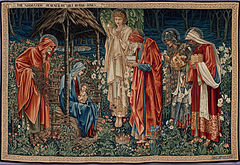 Epiphany is a Christian feast day that celebrates the revelation of God incarnate as Jesus Christ.
In Western Christianity, the feast commemorates principally (but not solely) the visit of the Magi to the Christ Child, and thus Jesus' physical manifestation to the Gentiles. It is sometimes called Three Kings' Day, and in some traditions celebrated as Little Christmas. Moreover, the feast of the Epiphany, in some denominations, also initiates the liturgical season of Epiphanytide.
Eastern Christians, on the other hand, commemorate the baptism of Jesus in the Jordan River, seen as his manifestation to the world as the Son of God. The spot marked by Qasr el Yahud in the West Bank, and Al-Maghtas in Jordan on the east bank, is considered to be the original site of the baptism of Jesus and the ministry of John the Baptist.
The traditional date for the feast is January 6. However, since 1970, the celebration is held in some countries on the Sunday after January 1. Those Eastern Churches which are still following the Julian calendar observe the feast on what, according to the internationally used Gregorian calendar, is January 19, because of the current 13-day difference between the Julian and Gregorian calendars.
In many Western Christian Churches, the eve of the feast is celebrated as Twelfth Night (Epiphany Eve). The Monday after Epiphany is known as Plough Monday.
Popular Epiphany customs include Epiphany singing, chalking the door, having one's house blessed, consuming Three Kings Cake, winter swimming, as well as attending church services. It is customary for Christians in many localities to remove their Christmas decorations on Epiphany Eve (Twelfth Night), although those in other Christian countries historically remove them on Candlemas, the conclusion of Epiphanytide. According to the first tradition, those who fail to remember to remove their Christmas decorations on Epiphany Eve must leave them untouched until Candlemas, the second opportunity to remove them; failure to observe this custom is considered inauspicious.
Etymology and original word usage
Epiphany is a Christian feast day that celebrates the revelation of God incarnate as Jesus Christ.
In Western Christianity, the feast commemorates principally (but not solely) the visit of the Magi to the Christ Child, and thus Jesus' physical manifestation to the Gentiles. It is sometimes called Three Kings' Day, and in some traditions celebrated as Little Christmas. Moreover, the feast of the Epiphany, in some denominations, also initiates the liturgical season of Epiphanytide.
Eastern Christians, on the other hand, commemorate the baptism of Jesus in the Jordan River, seen as his manifestation to the world as the Son of God. The spot marked by Qasr el Yahud in the West Bank, and Al-Maghtas in Jordan on the east bank, is considered to be the original site of the baptism of Jesus and the ministry of John the Baptist.
The traditional date for the feast is January 6. However, since 1970, the celebration is held in some countries on the Sunday after January 1. Those Eastern Churches which are still following the Julian calendar observe the feast on what, according to the internationally used Gregorian calendar, is January 19, because of the current 13-day difference between the Julian and Gregorian calendars.
In many Western Christian Churches, the eve of the feast is celebrated as Twelfth Night (Epiphany Eve). The Monday after Epiphany is known as Plough Monday.
Popular Epiphany customs include Epiphany singing, chalking the door, having one's house blessed, consuming Three Kings Cake, winter swimming, as well as attending church services. It is customary for Christians in many localities to remove their Christmas decorations on Epiphany Eve (Twelfth Night), although those in other Christian countries historically remove them on Candlemas, the conclusion of Epiphanytide. According to the first tradition, those who fail to remember to remove their Christmas decorations on Epiphany Eve must leave them untouched until Candlemas, the second opportunity to remove them; failure to observe this custom is considered inauspicious.
Etymology and original word usage
The word Epiphany is from Koine Greek epipháneia, meaning manifestation or appearance. It is derived from the verb phainein, meaning "to appear." In classical Greek it was used for the appearance of dawn, of an enemy in war, but especially of a manifestation of a deity to a worshiper (a theophany). In the Septuagint the word is used of a manifestation of the God of Israel (2 Maccabees 15:27). In the New Testament the word is used in 2 Timothy 1:10 to refer either to the birth of Christ or to his appearance after his resurrection, and five times to refer to his Second Coming. Alternative names for the feast in Greek include ta Theopháneia "Theophany" (a neuter plural rather than feminine singular), i Iméra ton Fóton (modern Greek pronunciation), "The Day of the Lights", and ta Fóta, "The Lights". History
Epiphany may have originated in the Greek-speaking eastern half of the Roman Empire as a feast to honor the baptism of Jesus. Around 200, Clement of Alexandria wrote that, "But the followers of Basilides celebrate the day of His Baptism too, spending the previous night in readings. And they say that it was the 15th of the month Tybi of the 15th year of Tiberius Caesar. And some say that it was observed the 11th of the same month." The Egyptian dates given correspond to January 6 and 10. The Basilides were a Gnostic sect.
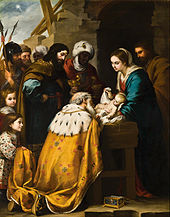 The reference to "readings" suggests that the Basilides were reading the Gospels. In ancient gospel manuscripts, the text is arranged to indicate passages for liturgical readings. If a congregation began reading Mark at the beginning of the year, it might arrive at the story of the Baptism on January 6, thus explaining the date of the feast. If Christians read Mark in the same format the Basilides did, the two groups could have arrived at the January 6 date independently.
The earliest reference to Epiphany as a Christian feast was in A.D. 361, by Ammianus Marcellinus. The holiday is listed twice, which suggests a double feast of baptism and birth. The baptism of Jesus was originally assigned to the same date as the birth because Luke 3:23 was misread to mean that Jesus was exactly 30 when he was baptized.
Epiphanius of Salamis says that January 6 is Christ's "Birthday; that is, His Epiphany" (hemera genethlion toutestin epiphanion). He also asserts that the Miracle at Cana occurred on the same calendar day. Epiphanius assigns the Baptism to November 6.
The scope to Epiphany expanded to include the commemoration of his birth; the visit of the magi, all of Jesus' childhood events, up to and including the Baptism by John the Baptist; and even the miracle at the wedding at Cana in Galilee.
The reference to "readings" suggests that the Basilides were reading the Gospels. In ancient gospel manuscripts, the text is arranged to indicate passages for liturgical readings. If a congregation began reading Mark at the beginning of the year, it might arrive at the story of the Baptism on January 6, thus explaining the date of the feast. If Christians read Mark in the same format the Basilides did, the two groups could have arrived at the January 6 date independently.
The earliest reference to Epiphany as a Christian feast was in A.D. 361, by Ammianus Marcellinus. The holiday is listed twice, which suggests a double feast of baptism and birth. The baptism of Jesus was originally assigned to the same date as the birth because Luke 3:23 was misread to mean that Jesus was exactly 30 when he was baptized.
Epiphanius of Salamis says that January 6 is Christ's "Birthday; that is, His Epiphany" (hemera genethlion toutestin epiphanion). He also asserts that the Miracle at Cana occurred on the same calendar day. Epiphanius assigns the Baptism to November 6.
The scope to Epiphany expanded to include the commemoration of his birth; the visit of the magi, all of Jesus' childhood events, up to and including the Baptism by John the Baptist; and even the miracle at the wedding at Cana in Galilee.
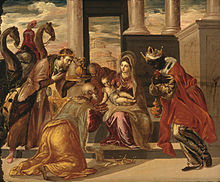 In the Latin-speaking West, the holiday emphasized the visit of the magi. The magi represented the non-Jewish peoples of the world, so this was considered a "revelation to the gentiles." In this event, Christian writers also inferred a revelation to the Children of Israel. John Chrysostom identified the significance of the meeting between the magi and Herod's court: "The star had been hidden from them so that, on finding themselves without their guide, they would have no alternative but to consult the Jews. In this way the birth of Jesus would be made known to all."
In 385, the pilgrim Egeria (also known as Silvia) described a celebration in Jerusalem and Bethlehem, which she called "Epiphany" that commemorated the Nativity. Even at this early date, there was an octave associated with the feast.
In a sermon delivered on 25 December 380, St. Gregory of Nazianzus referred to the day as "the Theophany" (ta theophania), saying expressly that it is a day commemorating "the holy nativity of Christ" and told his listeners that they would soon be celebrating the baptism of Christ. Then, on January 6 and 7, he preached two more sermons, wherein he declared that the celebration of the birth of Christ and the visitation of the Magi had already taken place, and that they would now commemorate his Baptism. At this time, celebration of the two events was beginning to be observed on separate occasions, at least in Cappadocia.
Saint John Cassian says that even in his time (beginning of the 5th century), Egyptian monasteries celebrated the Nativity and the Baptism together on January 6. The Armenian Apostolic Church continues to celebrate January 6 as the only commemoration of the Nativity.
Date of celebration
In the Latin-speaking West, the holiday emphasized the visit of the magi. The magi represented the non-Jewish peoples of the world, so this was considered a "revelation to the gentiles." In this event, Christian writers also inferred a revelation to the Children of Israel. John Chrysostom identified the significance of the meeting between the magi and Herod's court: "The star had been hidden from them so that, on finding themselves without their guide, they would have no alternative but to consult the Jews. In this way the birth of Jesus would be made known to all."
In 385, the pilgrim Egeria (also known as Silvia) described a celebration in Jerusalem and Bethlehem, which she called "Epiphany" that commemorated the Nativity. Even at this early date, there was an octave associated with the feast.
In a sermon delivered on 25 December 380, St. Gregory of Nazianzus referred to the day as "the Theophany" (ta theophania), saying expressly that it is a day commemorating "the holy nativity of Christ" and told his listeners that they would soon be celebrating the baptism of Christ. Then, on January 6 and 7, he preached two more sermons, wherein he declared that the celebration of the birth of Christ and the visitation of the Magi had already taken place, and that they would now commemorate his Baptism. At this time, celebration of the two events was beginning to be observed on separate occasions, at least in Cappadocia.
Saint John Cassian says that even in his time (beginning of the 5th century), Egyptian monasteries celebrated the Nativity and the Baptism together on January 6. The Armenian Apostolic Church continues to celebrate January 6 as the only commemoration of the Nativity.
Date of celebration
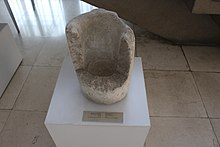 Until 1955, when Pope Pius XII abolished all but three liturgical octaves, the Latin Church celebrated Epiphany as an eight-day feast, known as the Octave of Epiphany, beginning on January 6 and ending on January 13. The Sunday within that octave was since 1893 the feast of the Holy Family, and Christmastide was reckoned as the twelve days ending on January 5, followed by the January 6–13 octave. The 1969 revision of the General Roman Calendar made the date to some extent variable, stating: "The Epiphany of the Lord is celebrated on 6 January, unless, where it is not observed as a holy day of obligation, it has been assigned to the Sunday occurring between 2 and 8 January." It also made the Feast of the Epiphany part of Christmas Time, which it defined as extending from the First Vespers of Christmas (the evening of December 24) up to and including the Sunday after Epiphany (the Sunday after January 6).
Prior to 1976, Anglican churches also observed an eight-day feast, beginning on January 6. Today, The Epiphany of our Lord, classified as a Principal Feast, is observed in some Anglican provinces on January 6 exclusively (e.g., the Anglican Church of Canada) but in the Church of England the celebration is "on 6 January or transferred to the Sunday falling between 2 and 8 January".
Lutheran, United Methodist and United Church of Christ congregations, along with those of other denominations, may celebrate Epiphany on January 6, on the following Sunday within the Epiphany week (octave), or at another time (Epiphany Eve January 5, the nearest Sunday, etc.) as local custom dictates.
Eastern churches celebrate Epiphany (Theophany) on January 6. Some, as in Greece, employ the modern Revised Julian calendar, which until the year 2800 coincides with the Gregorian calendar, the one in use for civil purposes in most countries. Other Eastern churches, as in Russia, hold to the older Julian calendar for reckoning church dates. In these old-calendar churches Epiphany falls at present on Gregorian January 19 – which is January 6 in the Julian calendar.
Epiphany season
Until 1955, when Pope Pius XII abolished all but three liturgical octaves, the Latin Church celebrated Epiphany as an eight-day feast, known as the Octave of Epiphany, beginning on January 6 and ending on January 13. The Sunday within that octave was since 1893 the feast of the Holy Family, and Christmastide was reckoned as the twelve days ending on January 5, followed by the January 6–13 octave. The 1969 revision of the General Roman Calendar made the date to some extent variable, stating: "The Epiphany of the Lord is celebrated on 6 January, unless, where it is not observed as a holy day of obligation, it has been assigned to the Sunday occurring between 2 and 8 January." It also made the Feast of the Epiphany part of Christmas Time, which it defined as extending from the First Vespers of Christmas (the evening of December 24) up to and including the Sunday after Epiphany (the Sunday after January 6).
Prior to 1976, Anglican churches also observed an eight-day feast, beginning on January 6. Today, The Epiphany of our Lord, classified as a Principal Feast, is observed in some Anglican provinces on January 6 exclusively (e.g., the Anglican Church of Canada) but in the Church of England the celebration is "on 6 January or transferred to the Sunday falling between 2 and 8 January".
Lutheran, United Methodist and United Church of Christ congregations, along with those of other denominations, may celebrate Epiphany on January 6, on the following Sunday within the Epiphany week (octave), or at another time (Epiphany Eve January 5, the nearest Sunday, etc.) as local custom dictates.
Eastern churches celebrate Epiphany (Theophany) on January 6. Some, as in Greece, employ the modern Revised Julian calendar, which until the year 2800 coincides with the Gregorian calendar, the one in use for civil purposes in most countries. Other Eastern churches, as in Russia, hold to the older Julian calendar for reckoning church dates. In these old-calendar churches Epiphany falls at present on Gregorian January 19 – which is January 6 in the Julian calendar.
Epiphany season
In some Churches, the feast of the Epiphany initiates the Epiphany season, also known as Epiphanytide. In Advent 2000, the Church of England, Mother Church of the Anglican Communion, introduced into its liturgy an optional Epiphany season by approving the Common Worship series of services as an alternative to those in the Book of Common Prayer, which remains the Church's normative liturgy and in which no such liturgical season appears. An official publication of the Church of England states: "The Christmas season is often celebrated for twelve days, ending with the Epiphany. Contemporary use has sought to express an alternative tradition, in which Christmas lasts for a full forty days, ending with the Feast of the Presentation on 2 February." It presents the latter part of this period as the Epiphany season, comprising the Sundays of Epiphany and ending "only with the Feast of the Presentation (Candlemas)". Another interpretation of "Epiphany season" applies the term to the period from Epiphany to the day before Ash Wednesday. Some Methodists in the United States and Singapore follow these liturgies. Lutherans celebrate the last Sunday before Ash Wednesday as the Transfiguration of our Lord, and it has been said that they call the whole period from Epiphany to then as Epiphany season. The Evangelical Lutheran Church in America used the terms "Time after Epiphany" to refer to this period. The expression with "after" has been interpreted as making the period in question correspond to that of Ordinary Time. The Presbyterian Church (U.S.A.) does not celebrate Epiphany or Pentecost as seasons; for this Church, expressions such as "Fifth Sunday after Epiphany" indicate the passing of time, rather than a liturgical season. It instead uses the term "Ordinary Time". In the Catholic Church, "Christmas Time runs from First Vespers (Evening Prayer I) of the Nativity of the Lord up to and including the Sunday after Epiphany or after 6 January"; and "Ordinary Time begins on the Monday which follows the Sunday occurring after 6 January". Before the 1969 revision of its liturgy, the Sundays following the Octave of Epiphany or, when this was abolished, following the Feast of the Baptism of the Lord, which was instituted to take the place of the Octave Day of Epiphany were named as the "Second (etc., up to Sixth) Sunday after Epiphany", as the at least 24 Sundays following Pentecost Sunday and Trinity Sunday were known as the "Second (etc.) Sunday after Pentecost". (If a year had more than 24 Sundays after Pentecost, up to four unused post-Epiphany Sundays were inserted between the 23rd and the 24th Sunday after Pentecost.) The Encyclopedia of Catholic Devotions and Practices, which has received the imprimatur of John Michael D'Arcy, with reference to Epiphanytide, thus states that "The Epiphany season extends from January 6 to Septuagesima Sunday, and has from one to six Sundays, according to the date of Easter. White is the color for the octave; green is the liturgical color for the season." Epiphany in different Christian traditions
Epiphany is celebrated by both the Eastern and Western Churches, but a major difference between them is precisely which events the feast commemorates. For Western Christians, the feast primarily commemorates the coming of the Magi, with only a minor reference to the baptism of Jesus and the miracle at the Wedding at Cana. Eastern churches celebrate the Baptism of Christ in the Jordan. In both traditions, the essence of the feast is the same: the manifestation of Christ to the world (whether as an infant or in the Jordan), and the Mystery of the Incarnation. The miracle at the Wedding at Cana is also celebrated during Epiphany as a first manifestation of Christ's public life.[60] Western Christian churches
.jpg) Even before the year 354, the Western Church had separated the celebration of the Nativity of Christ as the feast of Christmas and set its date as December 25; it reserved January 6 as a commemoration of the manifestation of Christ, especially to the Magi, but also at his baptism and at the wedding feast of Cana. In 1955 a separate feast of the Baptism of the Lord was instituted, thus weakening further the connection in the West between the feast of the Epiphany and the commemoration of the baptism of Christ. However, Hungarians, in an apparent reference to baptism, refer to the January 6 celebration as Vízkereszt, a term that recalls the words "víz" (water) and "kereszt, kereszt-ség" (baptism).
Liturgical practice in Western churches
Many in the West, such as adherents of the Anglican Communion, Lutheran Churches and Methodist Churches, observe a twelve-day festival, starting on December 25, and ending on January 5, known as Christmastide or the Twelve Days of Christmas. However, for the Catholic Church today, "Christmas Time runs from First Vespers (Evening Prayer I) of the Nativity of the Lord up to and including the Sunday after Epiphany or after January 6", a period not limited to twelve days. Some Christian cultures, especially those of Latin America and some in Europe, extend the season to as many as forty days, ending on Candlemas (February 2).
Even before the year 354, the Western Church had separated the celebration of the Nativity of Christ as the feast of Christmas and set its date as December 25; it reserved January 6 as a commemoration of the manifestation of Christ, especially to the Magi, but also at his baptism and at the wedding feast of Cana. In 1955 a separate feast of the Baptism of the Lord was instituted, thus weakening further the connection in the West between the feast of the Epiphany and the commemoration of the baptism of Christ. However, Hungarians, in an apparent reference to baptism, refer to the January 6 celebration as Vízkereszt, a term that recalls the words "víz" (water) and "kereszt, kereszt-ség" (baptism).
Liturgical practice in Western churches
Many in the West, such as adherents of the Anglican Communion, Lutheran Churches and Methodist Churches, observe a twelve-day festival, starting on December 25, and ending on January 5, known as Christmastide or the Twelve Days of Christmas. However, for the Catholic Church today, "Christmas Time runs from First Vespers (Evening Prayer I) of the Nativity of the Lord up to and including the Sunday after Epiphany or after January 6", a period not limited to twelve days. Some Christian cultures, especially those of Latin America and some in Europe, extend the season to as many as forty days, ending on Candlemas (February 2).
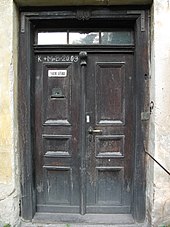 On the Feast of the Epiphany in some parts of central Europe the priest, wearing white vestments, blesses Epiphany water, frankincense, gold, and chalk. The chalk is used to write the initials of the three magi (traditionally, Caspar, Melchior, and Balthasar), over the doors of churches and homes. The initials may also be interpreted as the Latin phrase, Christus mansionem benedicat (may Christ bless the house).
According to ancient custom, the priest announced the date of Easter on the feast of Epiphany. This tradition dated from a time when calendars were not readily available, and the church needed to publicize the date of Easter, since many celebrations of the liturgical year depend on it. The proclamation may be sung or proclaimed at the ambo by a deacon, cantor, or reader either after the reading of the Gospel or after the postcommunion prayer.
The Roman Missal thus provides a formula with appropriate chant (in the tone of the Exsultet) for proclaiming on Epiphany, wherever it is customary to do so, the dates in the calendar for the celebration of Ash Wednesday, Easter Sunday, Ascension of Jesus Christ, Pentecost, the Body and Blood of Christ, and the First Sunday of Advent that will mark the following liturgical year.
Some western rite churches, such as the Anglican and Lutheran churches, will follow practises similar to the Catholic Church. Church cantatas for the Feast of Epiphany were written by Protestant composers such as Georg Philipp Telemann, Christoph Graupner, Johann Sebastian Bach and Gottfried Heinrich Stölzel. Many other Protestant groups do not celebrate or recognise Epiphany in any way.
Eastern Orthodox Christian churches
On the Feast of the Epiphany in some parts of central Europe the priest, wearing white vestments, blesses Epiphany water, frankincense, gold, and chalk. The chalk is used to write the initials of the three magi (traditionally, Caspar, Melchior, and Balthasar), over the doors of churches and homes. The initials may also be interpreted as the Latin phrase, Christus mansionem benedicat (may Christ bless the house).
According to ancient custom, the priest announced the date of Easter on the feast of Epiphany. This tradition dated from a time when calendars were not readily available, and the church needed to publicize the date of Easter, since many celebrations of the liturgical year depend on it. The proclamation may be sung or proclaimed at the ambo by a deacon, cantor, or reader either after the reading of the Gospel or after the postcommunion prayer.
The Roman Missal thus provides a formula with appropriate chant (in the tone of the Exsultet) for proclaiming on Epiphany, wherever it is customary to do so, the dates in the calendar for the celebration of Ash Wednesday, Easter Sunday, Ascension of Jesus Christ, Pentecost, the Body and Blood of Christ, and the First Sunday of Advent that will mark the following liturgical year.
Some western rite churches, such as the Anglican and Lutheran churches, will follow practises similar to the Catholic Church. Church cantatas for the Feast of Epiphany were written by Protestant composers such as Georg Philipp Telemann, Christoph Graupner, Johann Sebastian Bach and Gottfried Heinrich Stölzel. Many other Protestant groups do not celebrate or recognise Epiphany in any way.
Eastern Orthodox Christian churches
.jpg) The name of the feast as celebrated in the Orthodox churches may be rendered in English as the Theophany, as closer in form to the Greek word for "God shining forth" or "divine manifestation". Here it is one of the Great Feasts of the liturgical year, being third in rank, behind only Paskha (Easter) and Pentecost in importance. It is celebrated on January 6 of the calendar that a particular Church uses. On the Julian calendar, which some of the Orthodox churches follow, that date corresponds, during the present century, to January 19 on the Gregorian or Revised Julian calendar. The earliest reference to the feast in the Eastern Church is a remark by St. Clement of Alexandria in Stromateis, I, xxi, 45:
The name of the feast as celebrated in the Orthodox churches may be rendered in English as the Theophany, as closer in form to the Greek word for "God shining forth" or "divine manifestation". Here it is one of the Great Feasts of the liturgical year, being third in rank, behind only Paskha (Easter) and Pentecost in importance. It is celebrated on January 6 of the calendar that a particular Church uses. On the Julian calendar, which some of the Orthodox churches follow, that date corresponds, during the present century, to January 19 on the Gregorian or Revised Julian calendar. The earliest reference to the feast in the Eastern Church is a remark by St. Clement of Alexandria in Stromateis, I, xxi, 45:
And there are those who have determined not only the year of our Lord's birth, but also the day… And the followers of Basilides hold the day of his baptism as a festival, spending the night before in readings. And they say that it was the fifteenth year of Tiberius Caesar, the fifteenth day of the month of Tubi; and some that it was the eleventh of the same month.(11 and 15 of Tubi are January 6 and 10 respectively.) If this is a reference to a celebration of Christ's birth, as well as of his baptism, on January 6, it corresponds to what continues to be the custom of the Armenian Apostolic Church, which celebrates the birth of Jesus on January 6 of the calendar used, calling the feast that of the Nativity and Theophany of Our Lord. Origen's list of festivals (in Contra Celsum, VIII, xxii) omits any reference to Epiphany. The first reference to an ecclesiastical feast of the Epiphany, in Ammianus Marcellinus (XXI:ii), is in 361. In parts of the Eastern Church, January 6 continued for some time as a composite feast that included the Nativity of Jesus: though Constantinople adopted December 25 to commemorate Jesus' birth in the fourth century, in other parts the Nativity of Jesus continued to be celebrated on January 6, a date later devoted exclusively to commemorating his Baptism. Today in Eastern Orthodox churches, the emphasis at this feast is on the shining forth and revelation of Jesus Christ as the Messiah and Second Person of the Trinity at the time of his baptism. It is also celebrated because, according to tradition, the baptism of Jesus in the Jordan River by St. John the Baptist marked one of only two occasions when all three Persons of the Trinity manifested themselves simultaneously to humanity: God the Father by speaking through the clouds, God the Son being baptized in the river, and God the Holy Spirit in the shape of a dove descending from heaven (the other occasion was the Transfiguration on Mount Tabor). Thus the holy day is considered to be a Trinitarian feast. The Orthodox consider Jesus' Baptism to be the first step towards the Crucifixion, and there are some parallels in the hymnography used on this day and the hymns chanted on Good Friday.